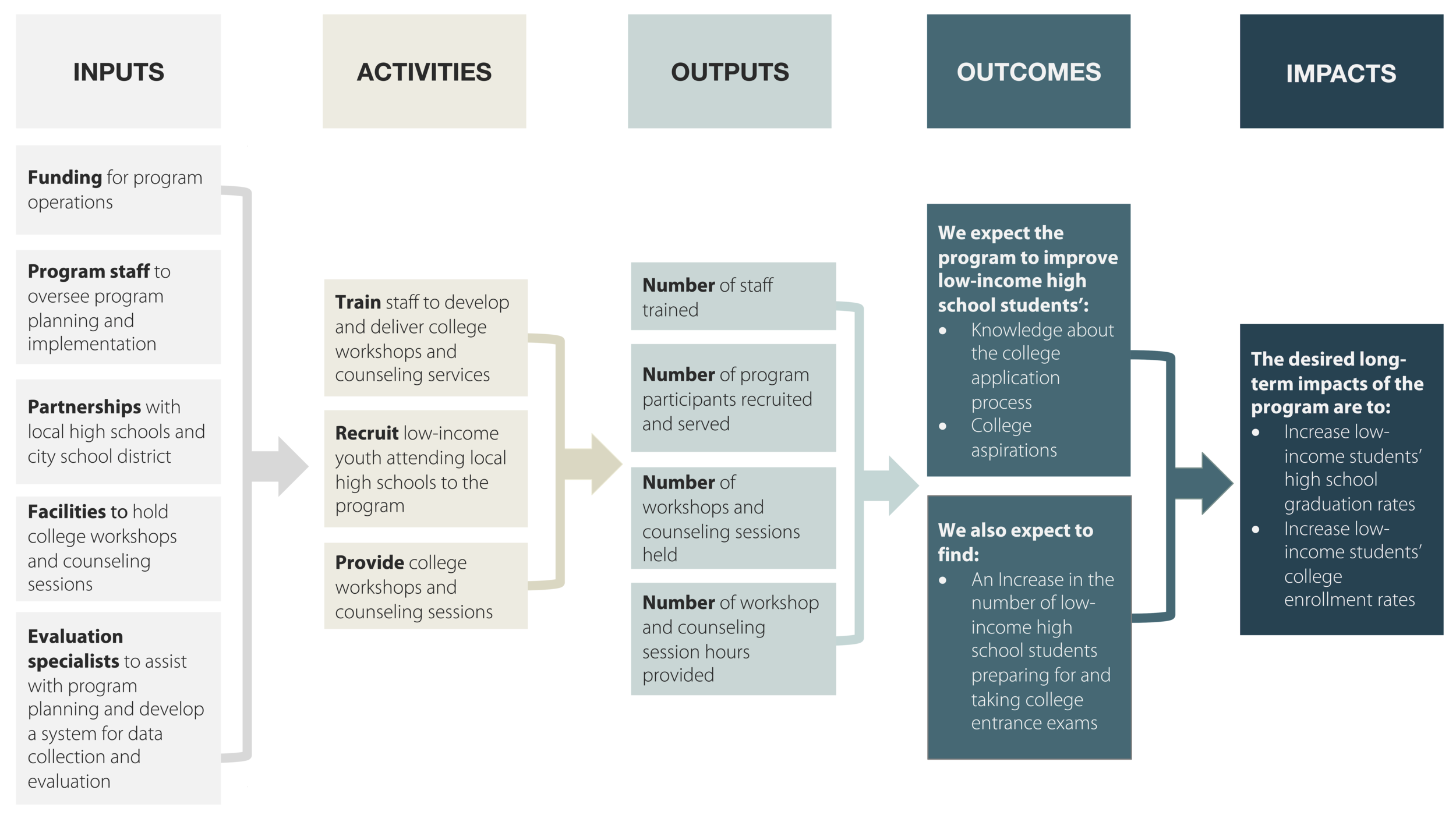Leveraging the Program Logic Model
I have never been a fan of the program logic model. However, I recognize the importance of creating one—both to drive program planning, implementation, and evaluation, and to demonstrate to organizational stakeholders/funders why they should invest in your program. In this post, I will share the basics of program logic model development as well as some key reasons to create one.
WHAT IS A PROGRAM LOGIC MODEL?
A program logic model graphically displays an organization’s (or individual’s) understanding of how a program’s desired outcomes and impacts will be achieved based on the resources available and activities undertaken in the program.
COMPONENTS OF A PROGRAM LOGIC MODEL.
Most program logic models have the following five key components:
Inputs: Resources needed to develop and implement the program (e.g., funding, staff, facilities);
Activities: Services offered and to whom as well as the methods for implementing the program (e.g., program activities, program administration);
Outputs: Results (or products) of program activities (e.g., number of service providers, number of program participants served);
Outcomes: Anticipated changes that occur because of the program (e.g., increased skills, change in attitudes or behaviors); and
Impacts: Desired long-term changes the program will bring about or contribute to (e.g., societal or group level changes in your target population).
Below is a table outlining each of the five components.
LOGIC MODEL DEVELOPMENT
There are two main approaches to developing a program logic model:
Forward logic; and
Reverse logic.
Forward Logic
Forward logic models are written from left to right as a series of “if-then” statements:
If we (as an organization) can access these inputs, then we can undertake these activities.
If we undertake these activities, then we can produce these outputs.
If we produce these outputs, then we can achieve these outcomes.
If we achieve these outcomes, then we will be able to realize these long-term impacts.
Reverse Logic
The reverse logic approach begins with identifying a program’s desired goals or long-term impacts, and then works backwards (right to left from outcomes to inputs) to determine a program’s outcomes, outputs, activities, and inputs. This is accomplished by asking (and answering) a series of “what” and “how” questions:
Identify your program’s desired long-term goal(s) or impact(s).
How can we demonstrate progress towards our long-term goal(s)? What outcomes can we measure? What changes are expected to occur?
What outputs are needed to produce the outcomes?
What activities are needed to produce the outputs and achieve the desired outcomes?
What inputs are needed to conduct the activities and how can those resources be obtained?

When to Use the Forward vs. Reverse Logic Approach
The Forward Logic Approach is most commonly used when a program is in the implementation stage or when an organization has already decided what resources will be dedicated to a program and which activities will be conducted. Most organizations opt to use the Reverse Logic Approach when a program is in the planning or development phase, and there is some degree of flexibility in selecting what activities will be undertaken to achieve a program’s goal(s) or long-term impact(s).
By using both approaches, however, an organization can better understand how a program works and is thought to bring about change. It can also help an organization identify whether the program activities they plan to undertake and outcomes and impact they hope to achieve are attainable.
AN EXAMPLE
Looking at an example is helpful for understanding how program logic models can be developed. Consider the following scenario:
Suppose you are asked by a local nonprofit to help them create a program logic model. The nonprofit is developing a high school college preparation program to improve the high school graduation and college enrollment rates of low-income students in CITY X. The new program is slated to equip low-income students attending local high schools with the knowledge and skills to successfully navigate the college application process by providing college workshops and counseling sessions. A key assumption of the program is that a lack of access to information about the college application process is an impediment to high school graduation and college enrollment, especially among low-income youth who are already less likely to graduate from high school or matriculate to college.
Using Forward Logic
In response to the above scenario, a sample logic model using forward logic could communicate the following:
If we have access to funding and facilities, form partnerships with local high schools and the city school district, and work with evaluation specialists, then we can train staff, recruit students to the program, and deliver college workshops and counseling sessions to low-income high school students in CITY X.
If we undertake these activities, then we can provide Y number of college workshops and counseling sessions to Z number of low-income high school students.
If low-income high school students participate in college workshops and counseling sessions, then they will gain knowledge about the college application process, improve their college aspirations, and prepare for and take college entrance exams.
If low-income high school students gain this knowledge, improve their college aspirations, and prepare for and take college entrance exams, then they will graduate from high school and enroll in college.
Using Reverse Logic
On the other hand, using reverse logic a sample logic model could convey:
Our long-term program goals are to improve the high school graduation and college enrollment rates of low-income youth in CITY X. How can we demonstrate progress towards these goals? What changes are expected to occur?
This occurs when low-income high school students gain knowledge about the college application process, improve their college aspirations, and prepare for and take college entrance exams. What outputs are needed to produce the outcomes?
Y number of low-income high school students complete Z number of college workshops and counseling sessions. What activities are needed to produce the outputs and achieve the desired outcomes?
Train staff, recruit students to the program and provide college workshops and counseling sessions. What inputs are needed to conduct the activities?
Secure staff, funding, facilities, and partnerships with local high schools and the city school district.
Using the text from both the Forward and Reverse Logic Approaches as a guide, we can construct a program logic model. The figure below shows a (basic) program logic model that you might develop.
REASONS TO CREATE A PROGRAM LOGIC MODEL
So, why develop a program logic model?
It visually communicates how your program works. Unlike lengthy proposals, program logic models offer a simple visual summary of a program. As such, program logic models can serve as a powerful communication tool to inform current stakeholders about program goals and activities and attract new donors that support your organization’s mission or work.
It provides a framework for evaluating a program. Developing a well thought out program logic model makes it easy for evaluators to determine what to measure and when. Once you have clearly identified all aspects of how a program operates and is expected to bring about change, evaluators can more quickly determine the appropriate methods to monitor program progress and assess whether the program is meeting its intended goals.
It can help strengthen your program. Developing a program logic model can help enhance a program’s ability to achieve its long-term goals in two key ways. First, program logic models can help identify organizational/community assets (e.g., reputation, partnerships) that can be mobilized to help a program succeed. Second, through the process of creating a logic model, resource gaps (e.g., lack of funding or staff capacity) and other barriers (e.g., policies that may affect coordination) that may influence program operations or performance can be revealed and resolved before a program is designed and implemented.
FINAL CONSIDERATIONS
A logic model should not be static. Over time organizational circumstances change and needs shift. For these reasons, program logic models should be regularly reviewed and updated throughout the life of a program.
No two programs are exactly alike. The logic model you develop for your program should be tailored to fit that uniqueness. However, when developing a program logic model always be sure to consider the following:
Who should be involved and engaged in the process?
What information is needed to guide its development?
How will the logic model be used once developed?
ADDITIONAL RESOURCES
Want to learn more? The following resources offer useful information on how to develop a logic model:




